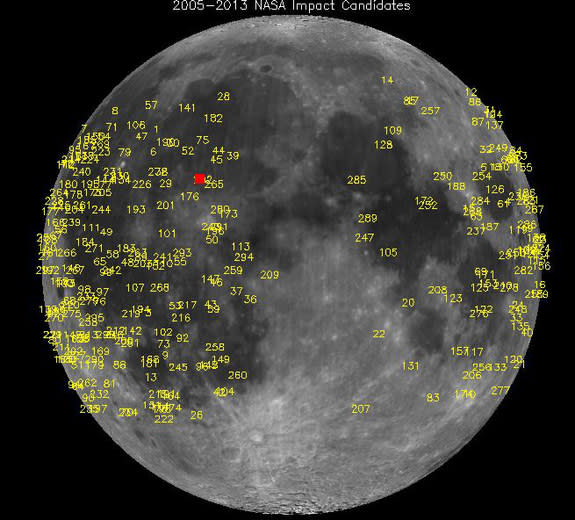Moon Crash Scene Investigation Tonight: See Telescope Views of Meteorite Impact
The lunar crash site from an meteorite strike on the moon is taking center stage in cosmic crime scene investigation and you can see the space rock impact zone online in a free webcast tonight (May 22).
The asteroid strike on the moon occurred on March 17 and marked the brightest lunar impact explosion seen since 2005, NASA scientists have said. The space agency announced the discovery of the impact last week.
Tonight, the online Slooh Space Camera will broadcast live views of the meteorite's impact site and you can watch the moon webcast on SPACE.com starting tonight (May 22) at 9 p.m. EDT (0100 GMT).
NASA scientists estimate that a 1-foot-wide (0.3 meters) meteoroid slammed into the moon at 56,000 mph (90,000 k/h) to carve a 65-foot (20 m) crater into the lunar surface. The resulting explosion would have been visible from Earth without a telescope and had the power of about 5 tons of TNT, NASA officials said.
"This is an unprecedented, first-time-ever event," astronomer and Slooh commentator Bob Berman said in a statement. "Apparently, a number of brilliant fireballs tore through Earth’s atmosphere just as the lunar surface received a visible impact bright enough to create a one-second point of light, seen by anyone watching the moon at that moment. This suggests that a fairly dense swarm of meteoroids zipped through our orbit at that time, two months ago."
During tonight's webcast, Slooh will stream in feeds from their observatory site in the Canary Islands off the coast of Africa while Berman and other experts will provide information about other near-Earth objects and meteorite impacts like the Feb. 15 meteor explosion in Siberia.
NASA scientists suspect the small asteroid that hit the moon weighed about 88 pounds (40 kilograms) at the time of the impact.
While the Earth's atmosphere prevented those space rocks from slamming into the planet, the atmosphere-less moon has no protection from these kinds of impacts.
Other scientists are also keeping an eye on the new moon crater. NASA's Lunar Reconnaissance Orbiter might take photos of the impact site, and researchers will continue to keep track of other moon- crashing space rocks.
To watch the Slooh webcast directly through the Slooh Space Camera website visit: http://events.slooh.com
Follow Miriam Kramer on Twitter and Google+. Follow us on Twitter, Facebookand Google+. Original article on SPACE.com.
Copyright 2013 SPACE.com, a TechMediaNetwork company. All rights reserved. This material may not be published, broadcast, rewritten or redistributed.

